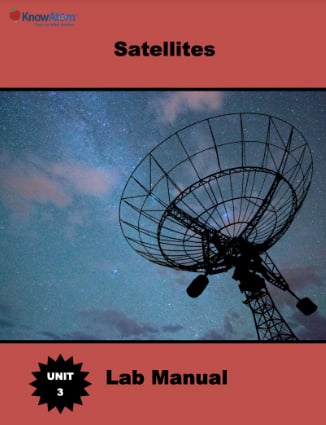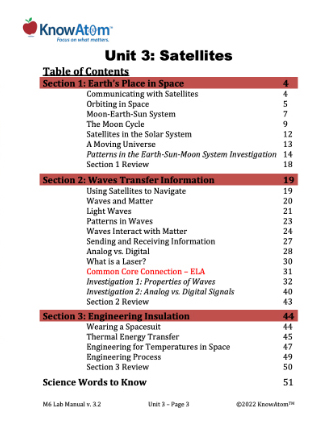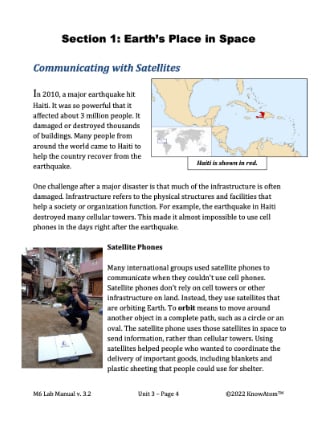In this lesson, students explore the properties of wave phenomena and develop investigative evidence to describe how different materials interact with the phenomena of light waves. They then compare the reliability of digital versus analog signals.
In this lesson, students explore the science phenomena of waves, investigating properties of waves, how waves carry energy, and how they can be used to transmit information. This page highlights key components of this lesson.
The science background section provides teachers with more in-depth information on the phenomena students explore in this unit. Here is an excerpt from this section on wave properties and signals.
To understand how satellites far above Earth can communicate with devices on the surface, even providing your exact location on the ground, it helps to understand waves. A wave is a disturbance that travels through space and/or matter, transferring energy as it moves. People can use waves in a variety of ways, including in GPS, cell phones, radio, microwaves, and CDs. Most waves fall into one of two categories: light waves (also called electromagnetic waves) and mechanical waves. For example, the waves in a slinky are mechanical waves because they are caused by vibrations in matter. Remember that matter is anything that has mass and takes up space. This matter is called a medium, and it can be a solid, a liquid, or a gas. For example, rock is a solid medium, as is a slinky. Water is a liquid medium, and air is a gaseous medium.
As mechanical waves travel through a medium, they cause molecules within the matter to bump into each other. As this happens, energy transfers from one molecule to the next. Regardless of how energy is moving through the wave, it is important to note that waves don’t carry matter. After the energy moves through, each coil of the slinky will return to its original position.
Another common mechanical wave is caused by throwing a pebble into a still lake. The kinetic energy of the rock transfers to the water, which creates water waves that carry that energy as they ripple outward. Once the ripples die down, the water returns to the same position.
Sound waves are another form of mechanical waves. Picture a person blowing into a trumpet. The energy of the person’s exhalation causes nearby air molecules to vibrate and bump into the molecules closest to them. This contact passes on the energy and makes them vibrate too. Then those molecules bump into more particles, and so on. Particles stop vibrating once they have passed on the energy.
Light waves are different from mechanical waves because they do not need a medium to travel. A light wave is a pattern of light energy that moves at a constant speed until meeting matter. Remember that the sun transfers energy to Earth through radiation (heat transfer that occurs without contact between the heat source and the object heated). That energy travels to Earth in light waves.
Exactly how light waves travel is very complex and scientists have many unanswered questions. However, scientists do know light waves can travel through a vacuum because the sun’s light reaches Earth through the vacuum of space. In contrast, sound cannot travel through the vacuum of space because there are vast empty regions between matter in space, which means that molecules are too far apart to transmit the energy.
There are many kinds of light energy. Microwaves heat up your food. X-rays are used at the dentist to capture images of teeth and at the airport to see through bags. Your radio captures radio waves that are sent out by radio stations. Navigation satellites send out microwaves. The type of light energy depends on the amount of energy in the different waves.
As waves move, they create a disturbance. Picture a pebble being thrown in a lake. The waves ripple outward, creating a disturbance in the water. However, not all waves create a disturbance that moves in the same direction. For example, some waves create a disturbance that moves perpendicular to the direction of the wave itself. In other words, if the wave moves from left to right, the disturbance moves up and down. This kind of wave is called a transverse wave. When a crowd of people in a stadium do “the wave,” they are modeling a transverse wave. The individual people move up and down, while the wave moves from side to side. This is another good example of how waves move energy, not matter. After the disturbance passes through, the people (matter) go back to where they were before. Light waves are transverse waves.
In some waves, the disturbance moves parallel to the direction of the wave itself. If the wave moves from left to right, the disturbance also moves left to right. This kind of wave is called a longitudinal wave. Sound waves are longitudinal. As sound waves move through a medium, the molecules of the medium collide with one another in the same direction the sound wave is moving.
In this lesson, students explore the properties of wave phenomena and develop investigative evidence to describe how different materials interact with the phenomena of light waves. They then compare the reliability of digital versus analog signals.

Prepared hands-on materials, full year grade-specific curriculum, and personalized live professional development designed to support mastery of current state science standards.
Amplitude : a measure of a wave’s displacement from its resting position
Communications System : a group of interacting components that function together to transmit or exchange information between people and equipment
Frequency : the number of waves that pass a set point in a given amount of time
Wave : a disturbance that travels through space and/or matter, transferring energy as it moves
Wavelength : the distance spanned by one cycle of the motion of a wave
Patterns in Waves
All waves represent repeating patterns. This can be understood by thinking about the anatomy of a simple wave. The wavelength is the distance spanned by one cycle of the motion of the wave. In transverse waves, it is usually measured as the distance between two crests (the top of the wave) or two troughs (the bottom of the wave).
In longitudinal waves, it is measured as the distance between compressions (points where the molecules are pressed together) or rarefactions (points where the molecules spread out).
Amplitude and Frequency
The amplitude is a measure of the wave’s displacement from its resting position. For example, in a water wave, its amplitude is its height above the water’s surface. In a mechanical wave, the amplitude is proportional to the amount of energy carried. This means that if the amplitude of a mechanical wave is doubled, each wave will have four times as much energy. In a light wave, the amplitude is related to its intensity, which we see as brightness. A light wave with a higher amplitude will be brighter than a light wave with a lower amplitude.
The frequency of a wave is the number of waves that pass a set point in a given amount of time. A wave with a greater frequency also has a shorter wavelength. If you look at the electromagnetic spectrum diagram on page 22, you’ll notice this pattern. Radio waves and microwaves have long wavelengths and low frequencies. X-rays and gamma rays have short wavelengths and high frequencies. Waves that have low frequencies and long wavelengths carry less energy than waves with high frequencies and short wavelengths. Remember that radio waves have the least energy of all electromagnetic waves.
Waves Interact with Matter
As waves move through space or matter, they continue in a straight line until they come into contact with a different medium, which changes their motion. There are different ways that a wave can behave after this interaction, but we’re going to focus on the three main ones: reflection, absorption, and transmission.
A wave is reflected when it encounters a substance that acts as a barrier. Light that is fully reflected will bounce off of the substance and back into your eyes. This is what happens when you look in a mirror. Your image is reflected back. That happens because light has reflected off of the mirror and back into your eyes. This is also how we are able to see the moon. The sun’s light reflects off of the moon’s surface and into our eyes on Earth.
A wave is absorbed when it hits a substance and causes the molecules of that substance to vibrate and move. This causes energy to be transferred away from the wave because it has been absorbed by the substance. Light that is fully absorbed will transform into another form of energy, usually thermal energy, which we feel as heat. The more an object's molecules move and vibrate, the hotter it becomes. This is why black objects become hotter than lighter objects. Black objects absorb all light waves and convert them into thermal energy. Finally light is transmitted when it moves through a substance. Transparent materials such as glass transmit light. This is why you can see through them.
How light behaves depends on the medium with which it is interacting. Some materials are more reflective or absorptive than others. It is because of this that we see the world in the colors that we do.
A small band of the electromagnetic spectrum is made up of visible light. Visible light is all of the light waves our eyes can see. Each color is determined by its specific frequency and wavelength.
Color of an Object
An object’s color is not within the object itself. Instead, the color of an object is determined by how that object interacts with light and then reflects, absorbs, or transmits it. When visible light hits an object, different frequencies are absorbed and reflected. For example, a strawberry is red because it absorbs all of the frequencies of visible light that shine on it except for the frequency associated with red.
Black and white are not actually colors because they don’t have a specific wavelength. Black objects absorb all wavelengths of light and convert them into heat. In contrast, white objects reflect all wavelengths of light.
As waves interact with matter, their properties can change. For example, as light moves from one medium to another, the wave can become bent. This is called refraction. Refraction occurs because light travels more slowly in air than it does in the vacuum of space. It moves even more slowly in water than it does in air. When a wave is refracted, its speed changes, as does its wavelength. However, its frequency remains the same.
Refraction is what happens when you look at an object that is partly in water and partly in air. The object appears bent at the water’s surface because light waves are bending at the boundary between the air medium and the water medium.
Rainbows
Light is being refracted, which is why this metal rod appears to be bent at the point where it enters the water. Rainbows are a result of light being refracted and then reflected by water droplets. Rainbows can occur whenever there are water droplets in the air. As the sun’s rays hit a water droplet, some of the light is reflected. Some of it is transmitted through the water drop.
The transmitted light refracts (bends) at the surface of the water droplet. When this refracted light hits the back of the water droplet, some of it is reflected and travels back to the surface again. Here, some of the light is reflected back into the water droplet. The rest is transmitted into the air as it exits the drop. The degree that the light wave is refracted depends upon its frequency, which determines its color. This is why rainbows form the arc of colored bands in the way that they do.



In this lesson students use slinky springs to develop mathematical representations of simple waves and models to describe how different materials interact with light waves. Then, they carry out a simulation to investigate the reliability of digital vs. analog signals. Students use the data from these experiments to figure out how waves carry energy and sometimes information.
KnowAtom incorporates formative and summative assessments designed to make students thinking visible for deeper student-centered learning.

Standards citation: NGSS Lead States. 2013. Next Generation Science Standards: For States, By States. Washington, DC: The National Academies Press. Neither WestEd nor the lead states and partners that developed the Next Generation Science Standards were involved in the production of this product, and do not endorse it.
